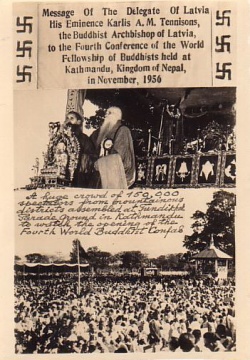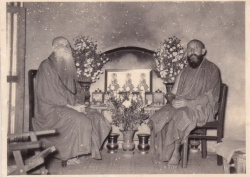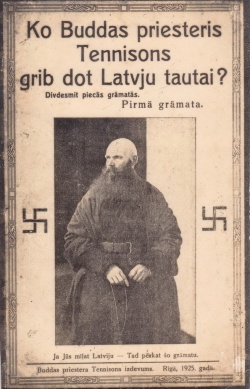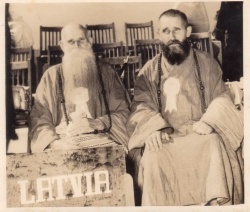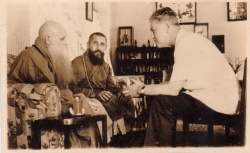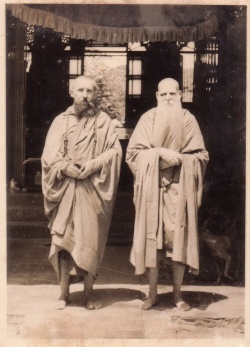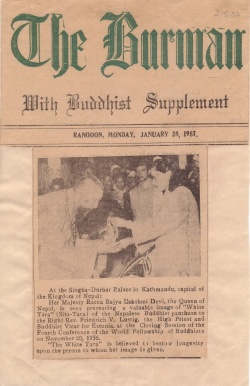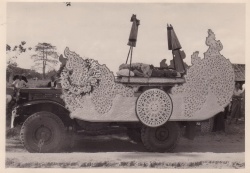I travel with Karl Tennisson by Tiit Pruuli
Good friends, my first trouble is that I’m not Tartu’s Buddhologist nor Tallinn’s Buddhist and the only justification why I am here could be that sometimes it seems to me that my journey goes with Karl Tõnisson. Actually, yes, I am a boy from Tartu and as to all boys form Tartu I was also told about Jaan Tõnissonist; my granddad told me about his companion from fraternity. My grandma told me about barefooted Tõnisson, one world traveler and geek, who did some crazy things in Tartu and Tallinn. I have to admit that I liked that barefooted Tõnisson much more than the politician Tõnisson, especially as I found from my granddad’s library a book named “Me and my disciples ” written by Mahatma Brother-Vahindra. What was so attractive to a young person in that book was its rebellious spirit, its going against worlds, its fighter’s confession, that looked at you from each line in that book, for example in the closing verse:
That was my first contact with Kaarel August Tõnisson a.k.a Karl Tennisson a.k.a Karlis Tennissons. A few times later through Gennadi Gerodnik (probably a hack-writer working for KGB), whose writings on two estonian men – Karl Tõnisson and his disciple Friedrich Lustig – and their buddhistic journeys through world unwillingly enraptured many history and adventure loving readers who grew up at 70s-80s. Decades later my own journeys started somehow to cross with Tõnisson’s. And about that I would like to talk a few words now and also to show some pictures about places, where we with Karl have been and some materials from Tõnisson’s and Lustig’s archives and from materials that we have managed to find in the world.
It was in 2004 when we were on a difficult journey along Pamir’s road in Tajikistan when my companion Karin Tiin told me a story. Karin is a quite important figure in everything that has followed with me and my connection with Tõnisson, that’s why I would like to show you a picture of Karin, and not only because she is pretty as well. Karin’s story inspired me so much that by today it has turned into a movie project, named “Baltic Buddha”. Karin herself has not lived in Estonia for years now and has been living in Thailand for last 8 years and worked as an advisor for the representative of UN in Burma and has visited Burma many times and has mediated Burma’s freedom fighters – Burma’s guerrillas – to the UN officials who can not commune with them officially and openly. So Karin told me that one Swedish correspondent from the journal Far East Economical View had suggested her before she went to Burma for the first time to ask from the locals in Burma whether they have heard the name of Friedrich Lustig. He was sure that they would know and said that as much as he has traveled through Southeast Asia Lustig is the best known estonian there. Later in North Burma Karin remembered his suggestion. She was on her way to a Catholic Mass with a south-indian priest Father Victor and she asked from Father Victor who had lived in Burma for years whether he has ever heard anything from Friedrich Lustig. Turning the wheel of his jeep that was decorated with a flag of Vatikan charismatic Father Victor had answered right away as naturally as if they would have been talking about holey road: “Oh yes, Ashin Ananda, I know him very well. Ashin Ananda was his name in Burma. We often met in Ranguun, he taught me English and lots of other things.” After that kind of success Karin stared to trace the marks of Ashin Ananda as she was adjusted to Burma and visited it often. Photographer Lobech Soe who is on this picture with the manuscript “The Mahatma and the Baltics –The Remarkable Life of the most Rev. Larlis A.M.Tennisons, the Buddhist Archbishop of Latvia” by Friedrich Lustig became her best assistant in that work. This young man worked hard to find through newspapers signs from Estonian Buddhists in Burma.
But I would like to start from the beginning, that is with the barefooted Tõnisson as traveler. What did Tõnisson do or not, where did he go or not is still in my opinion early to say in total confidence. There are very many sources, myths, folklore and documents. In my opinion two best known biographers – ideological enemy Gerodnik and ideological follower Lustig – can’t be trusted thoroughly. Because if Lustig really believes that Tõnisson was born in 1873, then Tõnisson, who was a very good speaker and very suggestive in spreading his ideas, must have succeeded in selling this myth to his disciple and we could not take Lustig too seriously. But if Lustig did not believed it, but just wrote down in his beautiful handwriting that you can see on this picture everything that Tõnisson told him, knowing it to be a lie, then we also can’t take him too seriously.
The first fantastical journey Tõnisson claimed to have made that is written down in Lustig’s book, i.e. in Tõnisson’s biography was the one with the heir to the throne Nikolai II to Asia, Far East. Indeed Nikolai II had a journey like that in 1890 during a 9-10 months period. But more creditable researcher Mait Talts has found out that Tõnisson was born in 1883 and I think he can be trusted in this. So if Tõnisson was born in Põltsamaa in 1883, then he was 7 years old at the time of Nikolai II’s Asia journey. But there are so many colourful exciting details about Tõnisson’s journey with Nikolai II in Lustig’s book, that reading those pages I have to admit that he somehow must have been there. Well, if we read those stories more seriously and calmly, then we can say with certainty that for example those pages that describe Nikolai’s visit to Siam are taken from Siam’s newspapers of that time. While being in Thailand in the 1930s Tõnisson and Lustig spent most of their time in libraries. Lustig’s descriptions are so journalistic that he probably wrote them down from newspapers in Thailand.
Next important Tõnisson’s jouney that Lustig describes was the one to Transbaikalia in 1892. He is said to have been in the monastery in Buryatia where he met a very old Lithuanian monk Gediminas who was Mindaugas’ descendant. Gedinina became Tõnisson’s guru, teacher and guide to buddhism. The only source that talks of Gedinina is Lustig’s book, even Mait Talts hasn’t found any trace of Buddhist Gediminas in Lithuenia. But the description on how Tõnisson got the ordination in Buryatia in 1893 is ethnographically, religiously very precise and emotionally very catching. I recommend it to everybody. There is also told that he visited many different monasteries in Buryatia. Those monasteries he speaks about really existed and were established at the first half of 19th century, but are destroyed by now. During my visit to Buryatia I tried to find archives of those monasteries where Tõnisson was said to stayed, but unfortunately none among buryats and buryan Buddhist could lead me to those archives and most of them thought that those archives were destroyed with the monasteries during Stalin’s period. According to Lustig Tõnisson came back to Latvia in 1898. I put here one postcard with Latvian flag that was between Latvian epos Lāčplēsis in Tõnisson’s and Lustig’s library in Ranguun in Burma.
Next journey took Tõnisson on the other side of polar circle to explain Buddhism to komis, yakuts, samoyeds, chukots and esquimaus and it lasted half of 1898 and the whole year of 1899. In October 1899 he met one Mongolian lama in Yakutia, who had lived previosly in Peking and who had come to Yakutia at the request of Agvan Doržijev. At the boost of that lama Tõnisson traveled to Peking in 1899 where he lived in the famous Yellow Temple. Among other things he witnessed the uprisal of boxers and the murder of infamous german minister baron von Ketteler. The description of that mureder is again written down in detail in Tõnisson’s biography by Lustig. Tõnisson as a great man had one amazing characteristics i.e. accidentally to run across historical persons and to witness historical moments, such as the murder of von Ketteler that shook the world. Tõnisson stayed in Peking till the end of 1901 and then made a little tour in China, Thailand and Siam that he compared to Venice in Europe. Then he traveled to China to the Holy Mountains, for example he talks about the Holy Mountains of the Province of Guiyang. And if you are looking at the tops of these mountains more closely, then the features of the face of Buddha seem to appear. In the temples around these Holy Mountains he spent a few weeks.
In november 1901 he went back to Russia, mainly to Kamchatka where he stayed till 1903. At the time of Japanese war that started in February 1904 was Tõnisson in Manchuria and according to Lustig he was acting on humanitarian field. 1905 he traveled to Mongolia to pass through the desert of Gobi. He got inspiration for that from the stories about the lost city Khara-Khoto. Russian explorer Kozlov found the ruins of this city a couple of years later in 1907. I have a little doubt although I haven’t checked it properly yet that these words about Khara-Khoto that according to Lustig belong to Tõnisson are actually from Pjotr Kozlov’s book that was published in Russian in 1923. In summer 1906 Tõnisson arrived from the desert of Gobi to Mongolia. He visited Karakorum the ancient capital of Mongolia and nearby monastery Erdene Džuu that was established in 1586. Tõnisson was fascinated by Mongolia and mongols and his loyal biographer Lustig wrote:
- “In all his wonderings throughout the world his eminence, most reverent Tõnisson had never met anywhere better people than mongols.”
From Karakorum Tõnisson travelled to Urgaa and according to Lustig here he was Bogdo Gegen’s personal quest. But he didn’t stay for long in Mongolia. He traveled to the Altai Mountains that was supposed to be “the original home of estonian people” and from there to Tova where he was “astonished by the wealth and number monasteries” and he learnt to drink the milk of broodmare. In February 1907 Tõnisson left Tõva and went through Orenburg, Samaara and Saraatov to the shores of Kaspia, to Astrahan where kalmyk buddhist have lived since 17th century. Here took place one of the most important meetings in Tõnisson life – meeting with Agvan Doržijev. He claims to have met also Leo Tolstoi in 1907 and 1908 and Keiserling. After those important meetings he went to Petersburg where he met again Doržijev and started to help him to establish Buddhist monastery, temple in Petersburg. According to his own words at this aim he and Doržijev met Aleksander II on 4th of August 1907 and a little later they met prime minister Stolõpin. With absolute certainty we can say that in 1907 was Tõnisson in Estonia and during many years he was travelling between Tallinn, Riga and Petersburg. He also tells about a journey in 1912 that took him to Montenegro and during that trip he visited also Austria, Serbia and Turkey.
These stories contain nothing new if to look at them from the Tõnisson’s point of view. In 1909 one of Tõnisson’s book was published “The life story of Tenisson in 306 verses”. In this book Tõnisson describes a world tour he had made through Africa, Australia, India, China, Siberia, South-America and Europe. A little bit different but basically the same version of his fantastic world tour is also presented in a book named “Great Master Buddha and His Moral Teachings”. It was published in 1911 and in its foreword he told about his life story.
These journeys are obviously “fibs” as Mait Talts says, I would say these are “dream travels”. So a big part of these journeys that Lustig writes of in Tõnisson’s life story can be categorized among “dream travels”, but with that categorization I don’t want to belittle Tõnisson – I actually do not think that real journeys are better than dream travels.
On no condition we can cross Tõnisson off the list of great travelers. For example, in Australia in Estonian archive are kept the memories of Ferdinand Luikvig where he writes:
- “In autumn 1920 a group of Estonians on their way back from Vladivastok to Estonia had to stop because of an obstacle on the railway. They had to stay and work in Mongoolia in Okinsky amiak for a couple of months. (Okinsky is in Buryatia and close to the monastery where Tõnisson claims to have stayed.) There they visited one Buddhist monastery. Their guide was a 50-years old russian speaking monk who rejoiced when he heard that the guests were Estonians and told them about an Estonian monk Karl Tennisson who years ago had stayed in their monastery and who left some Estonian booklets and other prints to the monastery. After that all 6 Estonians were entertained as dear guest; they were offered not unguinous Mongolian tea but Russian tea in porcelain teacups and were even given chocolate candies with tea.”
So we have some very tangible proofs about Tõnisson’s stay in Buryatia. Now we have talked a lot about Tõnisson and his journeys that whether took place or not, but now lets talk about something that we can be quite sure of – about Tõnisson and his disciple who traveled to Asia.
Friedrich Lustig was from Narva and his father was a goldsmith in Petersburg who came to Estonia in 1917. Lustig writes in his biography that he found Buddhism for himself while reading Ossendovski’s “Animals, humans and gods”. In another place he writes in his biography – actually he is not writing himself but there was someone in Burma who named himself archivist and wrote Lustig’s biography with the sentences quite Lustig-like – and there is said that Lustig in his buddhistic path was influenced by a french lady who visited their home in Narva and had explained there theosophic books by madam Helena Blavsky. In 1930 Lustig graduated from Russian Gymnasium of Narva. In spring 1930 Tõnisson visited Narva and they became at once very close and lifelong friends. In 1930 the prince of Siam visited Estonia and Tõnisson and Lutig met him unofficially. 1931 they started a journey to the promised land – Tibet. According to Tõnisson Dalai-Lama XIII had sent him an invitation in November in 1931 to come to Lhasa and give Dalai-Lama an overview about the situation in Europe. So Tõnisson and Lustig went to Marseille and from there to Singapore. They arrived to Bangkok on 31 December in 1931. They lived in different monasteries and their aim was to go to Tibet. For that they needed a visa from British authorities, but a month after their application they received a negative answer. They informed Dalai-Lama’s office in Lhasa about the negative answer and they were asked to stay in Siam. As I told they lived in different monasteries and temples – here is a picture of one of the most beautiful temples in Bangkok – What Pho, where they lived for a while. This mystical archivist writes about that time in Lustig’s life like that:
- “hier goes the years 1935-1936 as the best years in his life because the warmth and hospitality shown to his guru and him by the Chinese people.”
On the eve of World War II Thailand’s authorities wanted to send Baltic monks back and that journey was supposed to start on 4 September in 1939 and was supposed to take them to Copenhagen in Denmark. But as France and G.B. had just a couple of days before declared war to Germany the journey was cancelled and Tõnisson and Lustig stayed in Thailand during the japanies occupation. Craving for Tibet did not disappear. Lustig wrote in his diary on 5 February in 1943:
- “My dear teacher dreamed at night that he was in Lhasa and he went to Potala castle to ask for audience to His Holiness Dalai-Lama. One Tibetan official asked him to show his name card, but he did not have it and therefore he gave him his passport.”
On 2 March 1943 Lustig wrote:
- “I dreamed about a Tibetan lama who was dressed in violet coat and had come to Bangkok. He was sitting in a tram and was talking to me in Tibetan. I saw around his neck His Holiness Dalai Lama ’s medallion and I put it on my forehead.”
In Thailand Tõnisson’s and Lustig’s activity was actually quite controversial. As they wanted to go to Tibet so much they tried very different ways, among these belonged also a little flirt with Russians who lived in Bangkok. It’s written in Lustig’s diary how they borrowed Marxist literature from the libraries in Bangkok. He wrote:
- “Today for the first time in Thailand’s history the red soviet flag was fluttering in Bangkok. On the roof of our house.”
They had bought a red soviet flag and hung it on the roof of their house. They were in correspondence with the ambassador of Soviet Union or at least sent him letters – I haven’t seen any answer. But they sent letters to the soviet ambassador in Tokyo hoping to get some documents. As Estonia was occupied by Soviet Union then maybe they hoped to get some legal documents through Soviet Union, so that they could continue their travel to Tibet. At the same time among their papers there was a document written by chinese official “to the ship captain to whom it may concern” that said that if two baltic munks Tõnisson and Lustig want to from Thailand to China by ship, then captain is not allowed to take them on board and to China. So it didn’t matter how or how hard they tried. They wrote many articles to Bangkok Post that was first published in 1946. The establisher of this journal was an American officer MacDonald who described briefly Tõnisson and Lustig in his book that was published years later. Tõnisson’s and Lustig’s activity bothered Thailand’s authorities that much that they were arrested on 4 September 1949 and the next day they were taken to Lampangi and a night later they were forced to cross the borders in Tachileki and they were found by Burma’s border guards. So they were sent from Thailand to Burma that had just become indipendent in January 1948. Burma was already a little bit familiar to them as Ashin Ananda had taught french to the Burma’s ambassador in Bangkok. He was very good at languages, his diary is written in 4-5 languages. After some adventures they arrived to Ranguun and Scwedagon and they were allowed to stay in Burma. Now I come back to our journey. When we arrived to Burma in April 2005 then Karin and that photographer I told you about took us to Lustig’s disciple Maung Aung Khin who had become Lustig’s disciple when Vahindra was already dead. We interviewed him for hours and he told us about Lustig’s life in Schedagon, about their journeys in Burma and that Lustig was very highly respected person in Burma who was often invited to diplomatic receptions and other important events. The disciple spoke about his teacher whom he considered to be a great poet, and who had published many books of verse in english. He told about his many articles in Burmese, Thai and Indian journalism and of couse about those hundreds homeless dogs and cats that Tõnisson and Lustig took to their place to live with them.
We made a very important interview in Ranguun with Avagojathetoon. He has been in prison for 3 times since 1962 when military men came to power, he lives alternately in America and Burma. His father was a prosecutor in Burma in 1949 and he personally took Vahindra and Lustig under his protection and put them to live in the basement of his family house in the territory of Söragoni monastery, gave them food and corrody. Prosecutor’s son remembers how Tõnisson and Lustig were not very welcomed in Burma at the beginning because they differed a lot from the other monks with their long beards and their behavior. Lustig taught prosecutor’s young son to play piano – Lustig himself played Mozart, Schubert, Tchaikovski etc as Undhampool remembers. Once he told a story:
- „I remember a day Lustig brought a man with a huge drum, Lustig himself played Tsaikovski 1812 and that at his signal man beat the drum with all his force to. It was a great performance which I will not forget for the rest of my life. It was a strange scene to see a Buddhist monk playing a piano with such a great passion.”
We recorded a lots of important historical background material about Burma’s political situation in 50s and 60s that allowed Tõnisson and Lustig to stay there. American journalist Peter Jens told that Lustig had explained to him in 1987 when they met in Ranguun that he was allowed to stay in Burma only because he and Tõnisson were presented as the examples of Buddhist monks who ran away from communism. They wrote many articles on that subject in the local newspapers while a communist party planned to seize power in Burma.
But the most important achievement of our expedition to Burma was that after the conversations with leading monk of Shwedagon’s monastery he took us to the basement of the house that stood next to the western gate. In that basement were two cases full of documents - Lustig’s books, diaries, Tõnisson’s biography written by Lustig, photos, notes, postcards, correspondence and lots of other things and we managed to take most of the stuff with us to Estonia. All this material needs to be worked on.
There are many topics that could be briefly mentioned here, for example that they were not satisfied with their life in Burma and they wanted to travel to Nepal after they had visited buddhist conference there in 1956. They sent many letters to the king of Nepal asking for permission to live in Nepal permanently but the request was not granted. So much about Burma now.
I traveled to Buryatia hoping to learn to know Doržijev and I found from the small village of Atsagatski a museum that was devoted to Doržijev. In that museum I found next to posh wax figures of lamas a photo album that contained Doržijev’s life story and on the first pages were a portrait of Vahindra, his letter and a picture of him sitting together with other lamas on the steps of the temple. So I managed to make that kind of little finding in Buryatia. My last journey was to Australia to the archive of Hugo Saarsoo. Before his death Lustig sent a lots of his materials to Hugo Saarsoo. There was a lot of correspondence, for example a correspondence with misses Pank, who was an Estonian living outside of Estonia and who was believing in Taara. In this correspondence Lustig explains relationship between Buddhism and taara for example in the following way:
- “Faith in Taara is right, its one branch of buddhism and it is our duty to redeem Estonian people from the slavery of Jewish god and mythology that is low and derisory. Happiness, beauty, power, purity, wisdom, health, justice and order – that is taara. Stupidity and darkness – that is Christianity that was brought to the shores of Baltic sea with swords and flames. Difference is tremendous, like a day and a night, Lustig writes in 1963.”
In Australia was also the letter that Lustig’s disciple sent to the kind of Sweden (worksheet of that letter) where he asks the king of Sweden to influence Swedish Academy so that they would give Lustig a Nobel price in literature for his poems – beautiful poems of cause. Although brother Vahindra promised to live 200 years, were both he and his disciple Lustig mortals and in spring 1962 Tõnisson’s health worsened. In Lustig’s diary next to everyday problems that were mainly - how is the health of their cats and dogs and how did the morning meditation go – a new problem was added – a worry for his teacher’s life. For example:
- 4 May ‛62: „Teacher said – I am disappearing. Doctor excamined him again and said he was suffering of cathartic asthma”,
- 9 May ‛62: „My dear teacher left me to mourn here in samsara at 7.45 pm – Burma radio announces the sad news at the English program at 9pm.”
- 16. May 1962: „Today we bricked up the holy bones of my dear teacher in vanhinshan-bagodasse.”
The journeys with Tõnisson and Lustig are definitely not finished. There is a lot to discover and many exciting travels to make. And one example of how one travel could began is like that – when we were at Undhampool’s place in Ranguun he brought out a plastic bag under the sofa and asked us to take it with us to Estonia. He poured out the contains of that bag on a small table and there were the remains of his beloved teacher Karl Tõnisson – ashes and some bones that were not put into that Chinese temple. And his wish was that a part of Lustig’s ash would arrive to Estonia. At that time we could not take it with us but the wish of Lustig’s disciple is that this ash would once arrive to Estonia and that a stupa would be built here for the honor of his teacher. So this could be the next journey.
Source
Author : Tiit Pruuli
budcon.com
